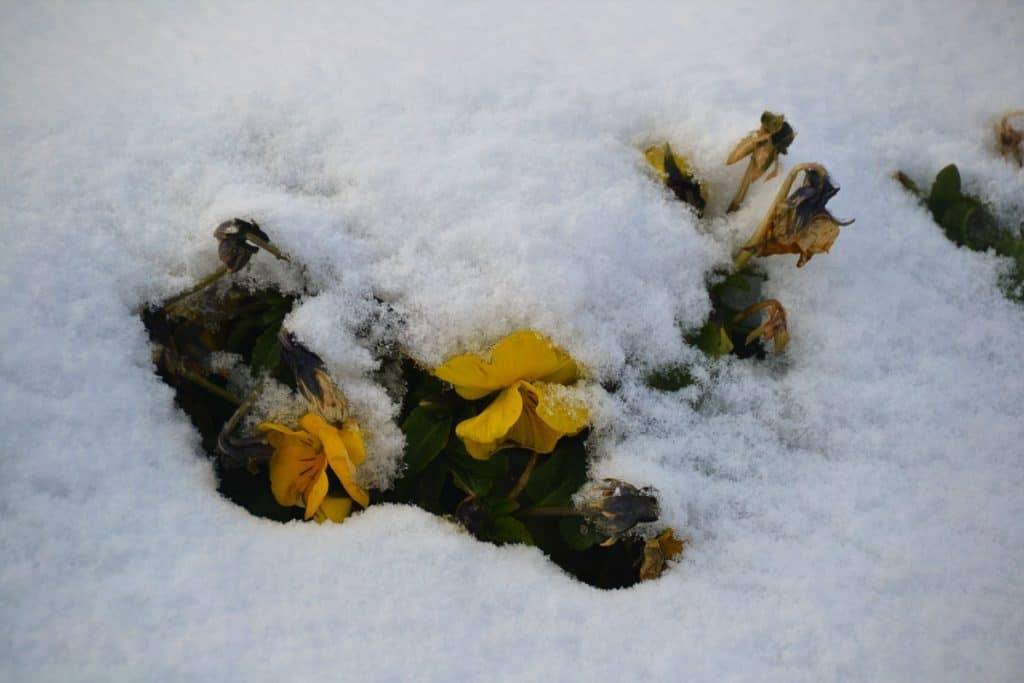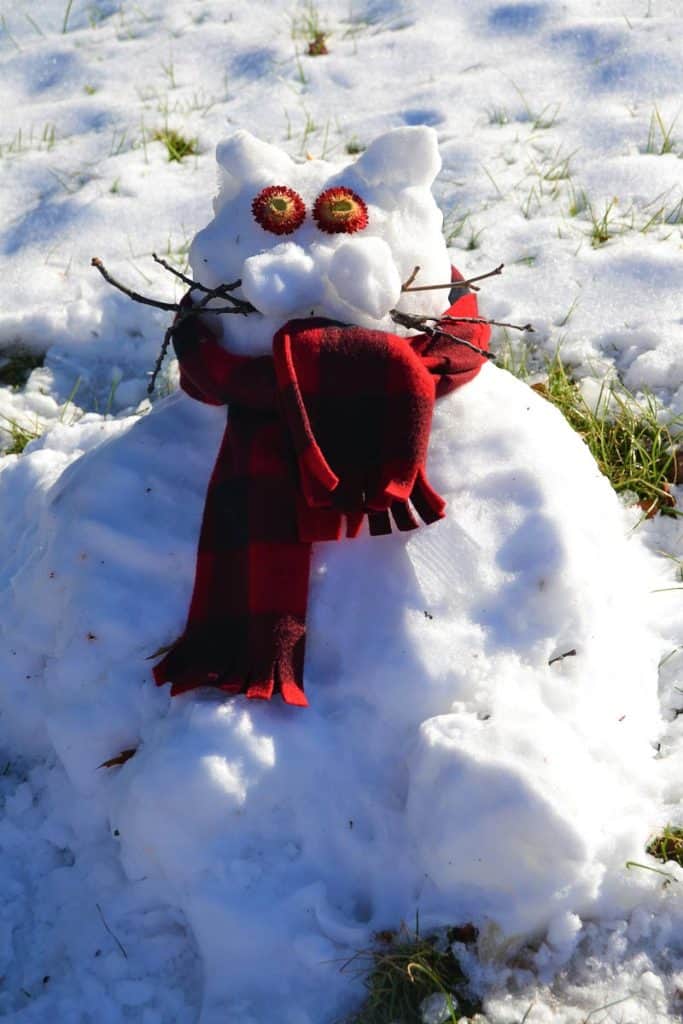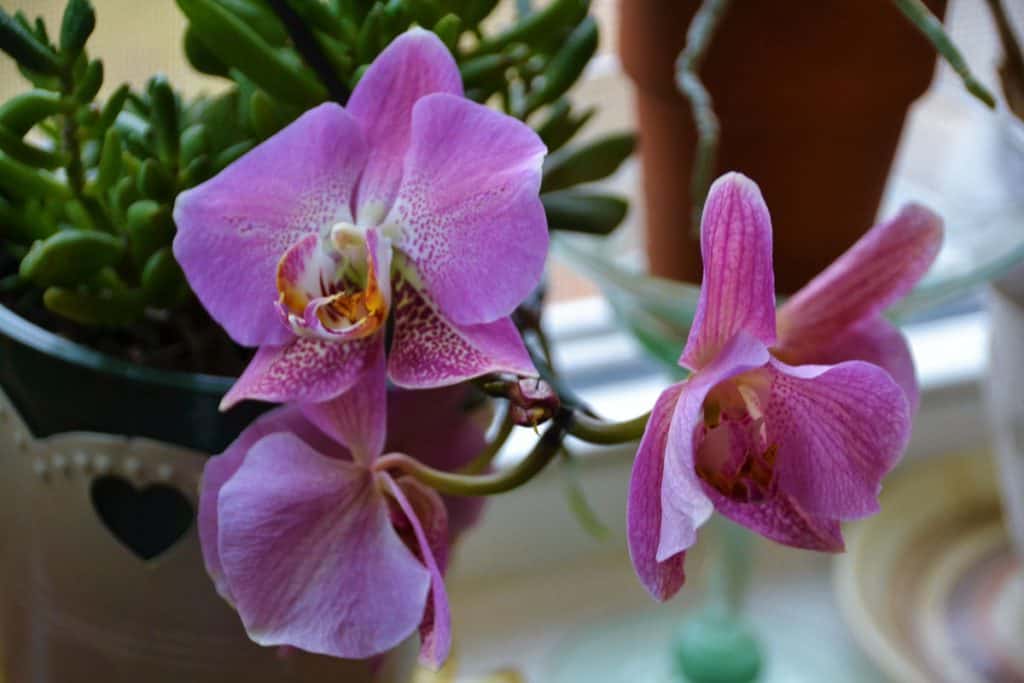Here’s what’s blooming in town this week to make your walks more enjoyable
This is the time of year when the fewest plants bloom in our climate, but it is still worth looking around because there are often wonderful surprises. A dusting of snow can alter the entire look of the landscape, and on a warmish day like Tuesday changes happen hour by hour. Peeking out from the snow at the entrance driveway to Bernie & Phyl’s furniture store on Route 1, some yellow ice pansies (Viola hiemalis) were showing their little faces on Martin Luther King Jr. Day. Ice pansies can bloom when temperatures are in the 40’s or even lower.
Lorraine DiMilla’s two gnomes last winter were very popular in her neighborhood, and this year she has made three! A very active garden lover and quilter, she sewed the gnomes’ caps and red mittens and fashioned their bodies from evergreen boughs. Last year’s noses were potatoes but this year they have more durable painted golf balls. Garden gnomes have become very popular in recent years, almost always sporting a tall conical cap, and often depicted with their cap brim down over their faces, no eyes visible, only a nose, with long white beards. Female gnomes, when seen, have a pair of long braids and short plump bodies. This winter I have seen gnomes indoors and outdoors, sometimes on skis or enjoying winter sports, and others getting out the watering can or holding a flower pot. Similar folklore characters have been around since at least the 16th century in northern Europe. They are earth dwellers similar to the dwarves of folklore who live underground in the mountains. Gnome figurines that we might recognize today as garden decorations began to be popular in the 19th century, although they did not always have beards and their faces were not always covered by their conical hats. Sometimes their activities were seen as mischievous, and other times helpful.
When the temperatures got cold outside, some of my potted plants that had spent the summer on my porch came indoors. One of these, a large pot of rosemary (Rosmarinus officinalis), is a shrubby herb in the mint family (Lamiaceae). On the North Shore of Massachusetts, our winters are not quite mild enough for this plant to survive, so while it doesn’t have to be whisked inside before the first frost, I usually move it indoors by the time the ground freezes. The hardy variety “Arp” does occasionally make it through the winter, but it is more reliable in zone 7, which in Massachusetts means the south shore of Cape Cod and the islands. Rosemary is an edible herb not dangerous to pets or people, so I am not too worried that my cat has decided to see if it tastes like catnip, which is, after all, in the same family.
Orchids are among the most popular flowering houseplants. The orchid family (Orchidaceae) is one of the largest flowering plant families with almost 900 genera divided into about 28,000 different species. Those sold as houseplants usually come from warm climates, so they are well adapted to the temperatures we tend to keep our rooms in our houses.
Moth orchids (Phalaenopsis spp.), including 70 different species, are among the most popular because they can have a wide range of showy flowers, and may bloom indoors for several months, as the plant on my front windowsill has. Flower stalks are often formed in response to a slight drop in temperature, so they often bloom in winter. In their native habitats, moth orchids may be pollinated by several species of bees, butterflies and moths. The name moth orchid probably came from the appearance of the flower shape.
Dendrobium orchids (Dendrobium spp.), which often have more pointed sepals than moth orchids, are also popular houseplants – this genus contains about 1,800 species. Most people are familiar with pink lady’s slipper orchids and a few related hardy orchids (Cypripedium spp.) which are native to our woodlands.
Less familiar are 16 species of bog orchids (Platanthera spp.) that grow in Massachusetts. Since they need beneficial fungi that live in vernal pools and bogs to survive, some of these species are endangered. The best-known orchid, however, is a tropical one grown for its flavor – whenever you taste “plain vanilla” (Vanilla planifolia), you are experiencing an orchid native to Mexico that is often grown commercially and popular over much of the world.
Editor’s Note: Laura Eisener is a landscape design consultant who helps homeowners with landscape design, plant selection and placement of trees and shrubs, as well as perennials. She is a member of the Saugus Garden Club and offered to write a series of articles about “what’s blooming in town” shortly after the outbreak of the COVID-19 pandemic. She was inspired after seeing so many people taking up walking.






